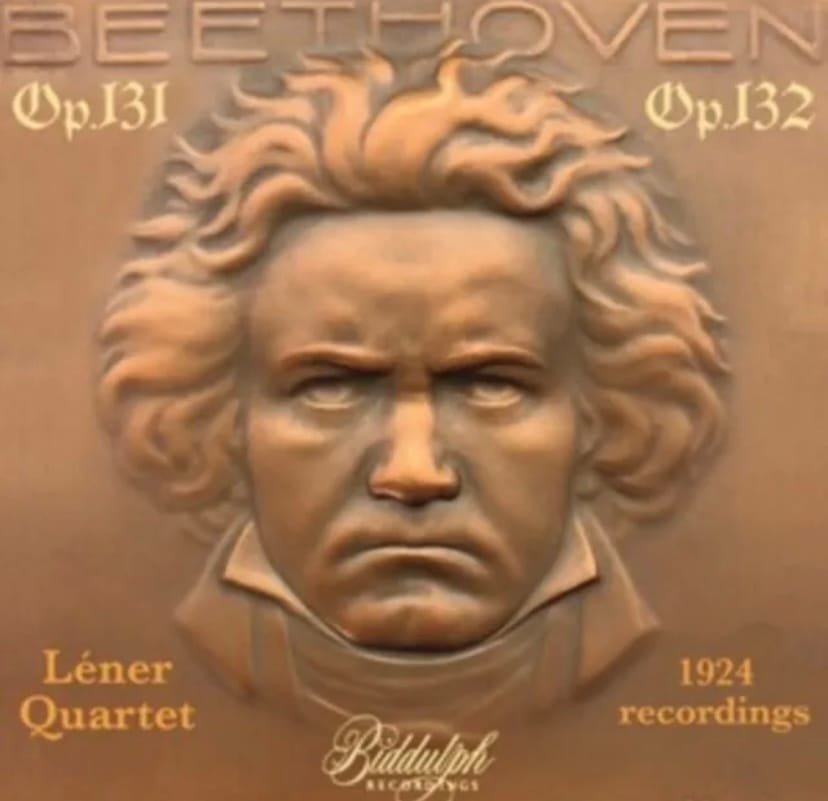Historic Beethoven from the Léner Quartet

The first group to record all of Beethoven's 16 String Quartets, the Léner Quartet was a group from Budapest. Three of the members were pupils of Jenő Hubay; founded in 1918, the line-up was Jenő Léner, violin I; Joszef Smilovits, violin II;
Sándor Roth, viola; Imre Hartman, cello. Also, while at the Budapest Academy, the group was coached by the great composer Leó Weiner.
What we have here is acoustic recordings of Opp. 131 and 132; a decade later the Léner Quartet re-recorded this repertoire electrically,
The performance of the first movement of Op. 131 is stunning. The marking for the first movement is “Adagio ma non troppo e molto espressivo" and this piece unfolds with a heavenly inevitability, Beethoven's miraculous counterpoint unfolding with supreme ease. Even more impressive is the emergence of rays of light in the extended fourth movement; it is in this movement, too, that one perhaps notices the excellence of the transfers most.
The first movement offers an example of absolute equivalence between the four parts within the confines of counterpoint; the extended plateau of the fourth sees motifs offered from one instrument, perfectly, a celestial conversation crowned at one point by a perfectly even trill from Léner himself. If there are faster Prestos (fifth movement), the Léner ensemble offers a masterclass in articulation. It is in teh slow movements that these performances achieve true greatness: the sixth movement (Adagio quasi un poco andante) is a two-minute plateau of calm before the determined tramp of the finale catapults the music forwards.
Although not in as fine sonics as the Biddulph, you can get a sense of the performance via this online YouTube of the 1924 recording.
The later performance was on Columbia L 1581/85; the electrics were also on Columbia, and you can hear that performance here. The accents within the main theme of the opening movement are certainly more pronounced here. I find the fourth movement has more character in the earlier performance, though. This video of the later performance is worth both listening to and watching as it presents a procession of photos (often signed) of the Léner Quartet:
The A-Minor Quartet, Op. 132, is arguably the one heard least in the concert hall, but it is a true gem. At its heart sits the “Heliger Dankgesang,” a 17-minute meditation set in the Lydian mode.
There is a slight skip in the first movement (taken from Columbia L 1672/1676 originals) and also in the second, but it is of little import. This is miraculous playing, Jenő Léner’s violin so pure in the third movement, the dialogues with second violin Jószef Smilovits exquisitely judged. The finale has a lightness to it, yet nevertheless manages to live up to its “appassionao” indicator.
The “Heiliger Dankgesang,” incidentally, is referenced in the last chapter of Aldous Huxley’s novel Point Counter Point:
Slowly, slowly, the melody unfolded itself. The archaic Lydian harmonies hung on the air. It was an unimpassioned music, transparent, pure and crystalline, like a tropical sea, an Alpine lake. Water on water, calm sliding over calm; the according of level horizons and waveless expanses, a counterpoint of serenities. And everything clear and bright; no mists, no vague twilights. It was the calm of still and rapturous contemplation, not of drowsiness or sleep. It was the serenity of a convalescent who wakes from fever and finds himself born again into a realm of beauty. But the fever was 'the fever called living' and the rebirth was not into this world; the beauty was unearthly, convalescent serenity was the peace of God. The interweaving of Lydian melodies was heaven.
For comparison, here’s the last three movements of the later 1935 performance:
It is almost sacrilege to say.this, but I would put these 1924 performances on the level of the eternal radiance of the Busch Quartet's classic recordings. Tully Potter, the esteemed author of the booklet notes and Omniscient Being on all things string quartet-y and violin-y, disagrees, although I do agree with him that the Léner does not quite capture the Elysian Fields the Busch Quartet invokes in the “Heiliger Dankgesang”. See what you think! I certainly agree that in the Léner’s Op. 132, there is plenty of “Central European intensity”!.
Here’s that Busch Quartet performance (the record collector in me wants to point out that the photo of the LP re-release box is the one I owned in my late teens!). Personally, I just find the Léner Quartet’s approach that bit more rigorous - and therefore more objective - which isn't necessarily a bad thing!:
The Léner/Biddulph recording is available via Amazon through this link.
